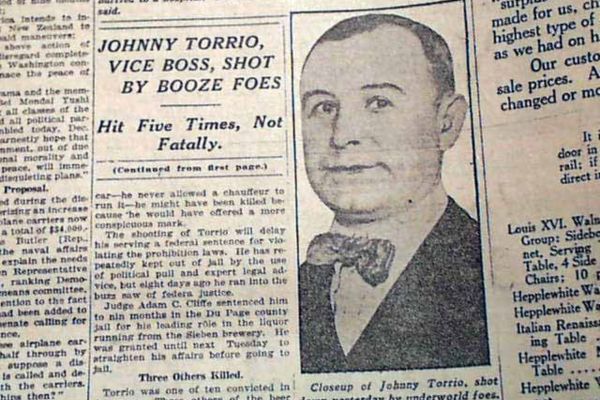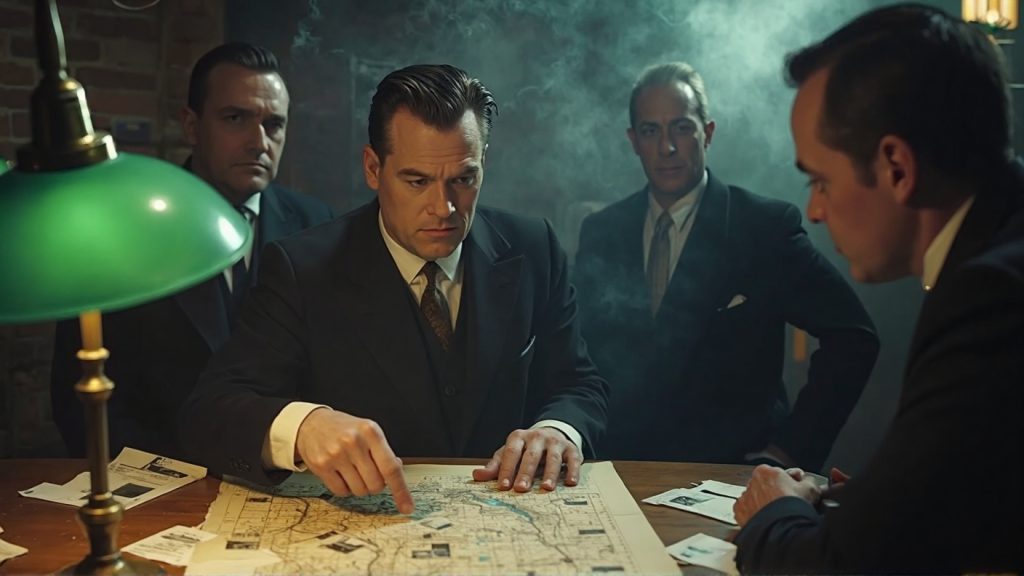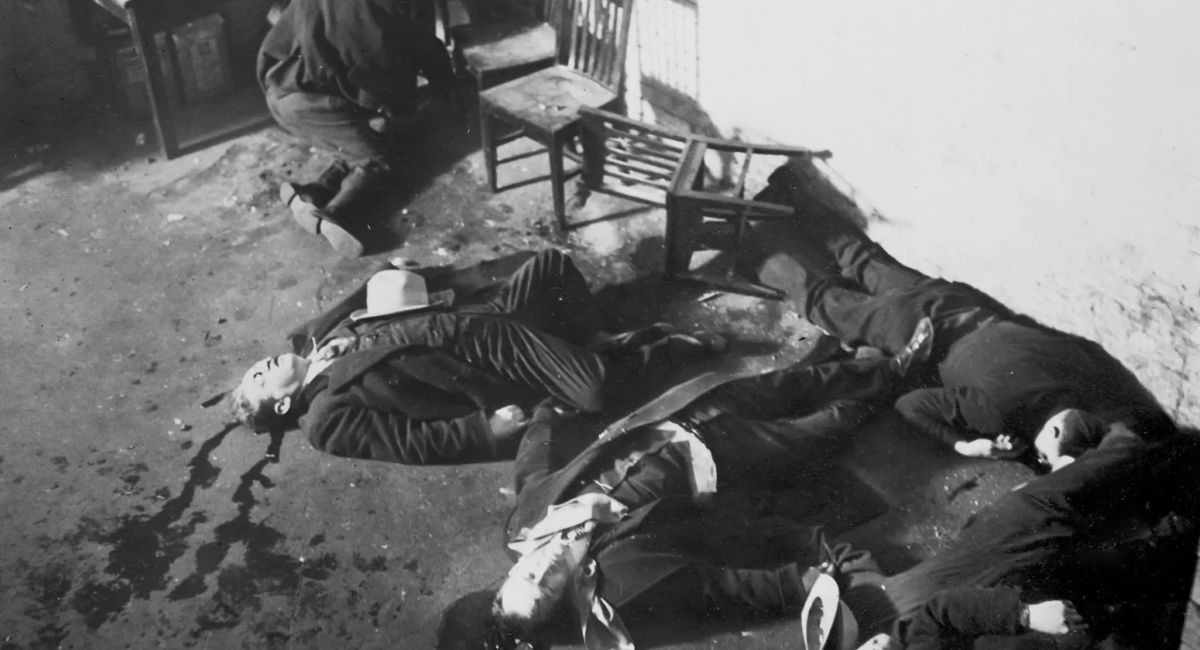In the winter of 1929, Chicago was a city on edge. The streets bustled with Model T’s and bundled-up pedestrians, but under the hum of everyday life, a different engine was running—one fueled by bootleg hooch, bribes, and bullets.
The wind off Lake Michigan could chill a man to the bone – but it was nothing compared to the cold war brewing between two of the city’s most dangerous men: Al “Scarface” Capone and George “Bugs” Moran.
Contents
The Making of a Gang War

The roots of their feud stretched back to 1924, when North Side mob boss Dean O’Banion was gunned down in his own flower shop by killers tied to Johnny Torrio, Capone’s mentor.
O’Banion’s death lit the fuse for a gang war that would last years.
Torrio barely survived a revenge shooting the following year and, badly shaken, handed the reins of the Chicago Outfit to Capone.
Capone was no small-time hustler. Born in Brooklyn, he’d built a reputation as a ruthless and ambitious operator.
By the mid-1920s, his Outfit dominated the city’s South Side, pulling in tens of millions from bootlegging, gambling, and vice.
The North Side, however, refused to bow.
First under Hymie Weiss, then under George “Bugs” Moran—a sharp dresser with a volatile temper—the Irish-American crew kept striking back.
The fight wasn’t just about territory; it was about pride. Moran hijacked Capone’s liquor shipments, muscled in on his speakeasies, and even took over a dog track Capone considered his own.
The two traded assassination attempts like poker chips. One drive-by sprayed Capone’s headquarters in Cicero with over a thousand bullets. Another left Moran dodging hitmen on his own turf.
By 1928, the war was personal. Moran’s gang was suspected in the murders of two of Capone’s allies—Patsy Lolordo and Antonio Lombardo, both important Mafia figures.
The rumor mill claimed Moran had even put a $50,000 bounty on Capone’s head. For Capone, that was the last straw.
Setting the Trap
February 14, 1929, dawned bitterly cold. Sometime that morning, Moran’s men were told about a special opportunity—a truckload of high-quality Canadian whiskey available at a bargain.
The delivery point: the SMC Cartage Company garage on North Clark Street, one of their regular hangouts.
Moran planned to be there at 10:30 a.m., but he was running late. That delay would save his life.
As Moran approached the garage, he saw what looked like a police car pull up.
Four men got out—two in crisp police uniforms, two in civilian clothes.
Believing the cops were about to raid the place, Moran hung back, slipping away before anyone spotted him.
Inside, his men didn’t know it was a trap. The two “officers” strode in, ordering everyone to line up against the wall.
The rest of the crew complied, thinking they’d be frisked and maybe fined. Then came the signal. The men in civilian clothes raised Thompson submachine guns.
What followed was chaos compressed into seconds—about 70 rounds tearing through the garage, echoing like thunder in the closed space.
As the smoke cleared, shotgun blasts finished the work. Seven men lay sprawled in the sawdust and grease: five of Moran’s gang and two unlucky associates.
A Chilling Scene

The killers didn’t run; they acted. To nearby witnesses, it looked like the police were arresting two plainclothes men.
The four walked calmly to a waiting car—a stolen police vehicle—and vanished into the city.
Minutes later, real police arrived to find a scene of horror. The victims were slumped against the bullet-pocked wall, their faces and bodies riddled with holes.
Miraculously, one man—Frank Gusenberg—was still breathing despite fourteen bullet wounds.
Officers pressed him for names, but Gusenberg stuck to the gangster code of silence: “Nobody shot me,” he rasped, “For God’s sake, get me to the hospital!” Gusenberg died three hours later.
Among the dead were Moran’s brother-in-law, Albert Kachellek (alias James Clark), and top enforcers Frank and Peter Gusenberg. The hit had gutted the North Side Gang’s leadership in one morning.
Shockwaves Across the Nation
News of the massacre spread fast. Chicago had seen plenty of bloodshed during Prohibition, but this was different. The date—Valentine’s Day—gave it a macabre twist that journalists couldn’t resist.
Photos of the crime scene splashed across front pages nationwide, and the public began to wonder if the city had completely lost control.
Bugs Moran didn’t mince words with reporters: “Only Capone kills like that.” Capone, lounging in Florida with an alibi, shot back, “The only man who kills like that is Bugs Moran.”
The back-and-forth was pure thee-ater, but few doubted who had ordered the hit.
Even President Herbert Hoover was alarmed. Within weeks, he told his attorney general to “get Capone” by any legal means necessary.
Federal agents began peeling back the layers of Capone’s empire.
The Downfall

Ironically, the massacre that cemented Capone’s power in the underworld also accelerated his fall. Moran’s gang was shattered, leaving Capone unrivaled in Chicago’s bootlegging trade.
But the outrage brought relentless federal pressure. Unable to tie him directly to the murders, investigators went after him for other crimes.
By 1931, Capone was in court—not for murder, but for tax evasion. The verdict: guilty, with an eleven-year prison sentence. “Public Enemy No. 1” was finally behind bars.
Moran’s story ended differently but no less grimly. Without his key lieutenants, he slipped into minor crimes, arrested in 1946 for a bank robbery.
He died of lung cancer in Leavenworth Prison in 1957—a far cry from his days as Capone’s greatest rival.
The Last Shots
Seven years to the day after the massacre, one of its suspected triggermen met his own violent end. “Machine Gun” Jack McGurn, long believed to have orchestrated the attack, was gunned down in a Chicago bowling alley.
The hit mirrored the massacre—quick, brutal, and silent. Some whispered that it was Moran’s long-delayed revenge.
The Birth of Modern Forensic Science
The crime scene was unlike anything police had encountered before. Seven bodies, dozens of bullet trajectories, and a sophisticated criminal operation that left few clues.
For the first time, investigators began systematically analyzing ballistics evidence. They studied the bullet patterns, examined shell casings, and attempted to trace the weapons used in the attack.
This case helped establish the science of forensic ballistics in American law enforcement.
Investigators realized that every gun leaves unique markings on bullets and cartridge cases – like fingerprints, but for firearms.
The massacre also highlighted the need for better crime scene photography and evidence preservation. The brutal efficiency of the killers showed authorities they needed to match that precision with scientific investigation methods.
While the perpetrators were never officially identified, the forensic techniques developed in response to this case would solve countless future crimes.
The St. Valentine’s Day Massacre became an inadvertent catalyst for modern criminal investigation.

